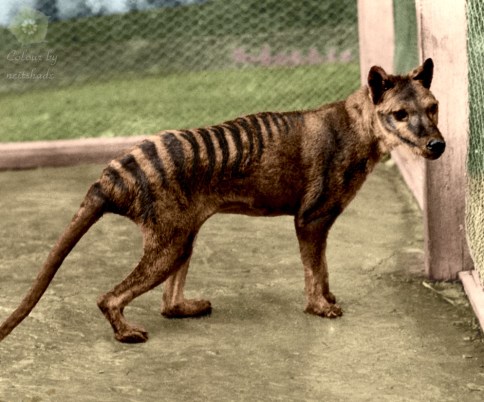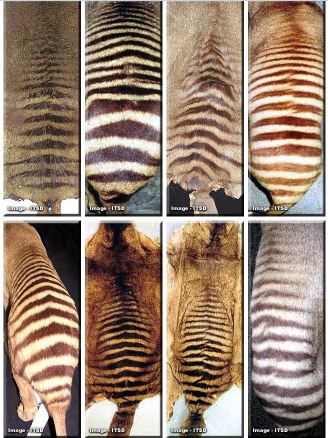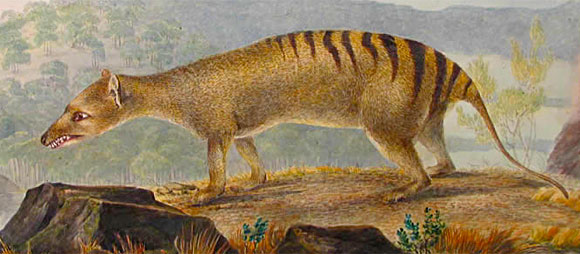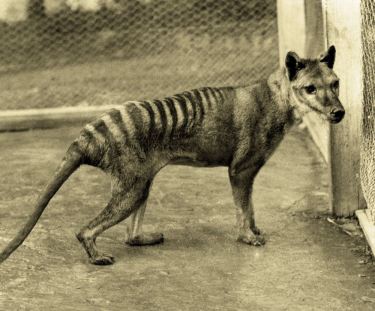The last known Thylacinus cynocephalus in existence died in 1936, at Hobart Zoo. This photo is, as far as I can ascertain, that animal, and I think it dates from 1933. *
Most commonly known as the Tasmanian Tiger, because of the stripes, it’s sometimes called the Tasmanian Wolf, as it has dog-like features. In fact, it was neither, but a marsupial that had evolved to fill a similar ecological niche to those creatures.
My first attempt, with brighter colouration, based on contemporary paintings. I redid this photo after a comment (see below) suggested more subdued colours. I prefer my new version, but I can’t be certain the old one is wrong. The commenter, Gareth, has provided some information that may help though. First, a link to a comprehensive website about the Tasmanian Tiger, from which these pictures of skins come:
These pictures would seem to confirm that there was a fair bit of variation (though it has been pointed out that the pelts are in poor condition which affects the colour) and this painting from 1817, by John Lewin has a definite red tinge to it, which may have been picked up by later artists, and exaggerated.
So it looks like either of my versions could still be right.
Except Gareth also gave me a name, Alison Reid. Alison was the main keeper for the Tasmanian tigers and de facto curator of the zoo when the last of them died, and described them as being ‘dun’ or ‘rabbit’ coloured. Since the animal in the photo is one of those she was most familiar with, I think the colours I used in the new version are most likely correct. There may have been other more brightly coloured Tasmanian Tigers, but probably not in Hobart Zoo.
* Correction: It seems that this photo was probably taken in 1928, and is of a juvenile male that died the day after it was photographed.






Yeah it does look like a Jackal. Good work!!
LikeLike
I love your work on this photo, there’s only one thing I’m afraid the colour is wrong. I don’t mean to be critical because as I say it does look great, but they were actually a grey/dun colour with white facial markings.
LikeLiked by 1 person
Thanks! I’m not sure the colours are wrong, exactly, but I was never that confident to start with!
My references were paintings, mainly the ones done while the animal was still around, but they were a bit garish, so I toned them down quite a lot. I think there was probably a bit of variation, both with the main colour, and with the facial markings, so I won’t be replacing the picture above, but I’ll have a go at another one, using the colours you’ve suggested.
LikeLike
I am author of the 1983, 1991, and 1999 editions of “Walker’s Mammals of the World” (Johns Hopkins University Press). An updated volume, which will include the thylacine, will be published next year. A long-term objective has been to have a good photo of an entire live individual of every genus. Until now, all photos have been in black-and-white, but we are trying to obtain all-color illustrations for the new volume.
I was impressed with your careful work on the thylacine and, though it would be somewhat unorthodox, I would like to have your colorized photos considered for use in the new book.
If this is something you might be able to help with, could you please contact my email address, so that we could discusss further details?
Thank you
LikeLike